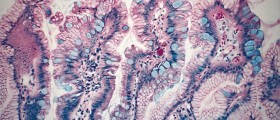Benign mammary dysplasia is a benign condition (as the name suggests) that affects women and is characterized by an abnormal growth (dysplasia) of the breast tissue.
Basic characteristics of this medical condition are swelling (a lump) in the breast, discomfort and increased sensitivity of the nipples. Benign mammary dysplasia is closely related to the menstrual cycle (it is under hormonal influence). This is why symptoms and signs depend on the part of the menstrual cycle and they frequently subside once a woman enters menopause.
Benign mammary dysplasia most commonly affects women between the age of 30 and 50.

Benign Mammary Dysplasia Causes
The actual cause of this benign medical condition remains mystery. Still, it is clear that benign mammary dysplasia has something to do with female hormones because the symptoms depend on hormonal changes characteristic for the menstrual period.
It is normal to experience different hormone fluctuations during each monthly cycle. The condition is mostly connected to fluctuation of estrogen and progesterone although it may be connected to certain extent to other hormones such as prolactin, growth factor, insulin and thyroid hormones.
Furthermore, it is believed that a family history of the condition, diet rich in fat as well as intake of too much caffeine may be blamed for benign mammary dysplasia.
Finally, the risk for benign mammary dysplasia is higher in women who take birth control pills.
Benign Mammary Dysplasia Clinical Characteristics
The affected breast may be a bit swollen with palpable lump inside. Pain is another typical characteristic of the condition. The nipples, sometimes the entire breasts, can be itchy. Patients complain about discomfort in one or even both breasts.
Symptoms and signs usually become more intensive just before the period. They subside immediately after menstruation ceases.
Diagnosing Benign Mammary Dysplasia
Diagnosis of benign mammary dysplasia is set after physical examination, mammography and biopsy. Biopsy is the best way to confirm the condition or rule it out.
Benign Mammary Dysplasia Treatment
Unfortunately, there is no efficiency cure for benign mammary dysplasia. The treatment is, therefore, symptomatic with one goal - alleviation of most, if not all symptoms.
Women may be, for instance, prescribed anti-inflammatory drugs, supplements such as vitamin A, B6, C and E while some of them also benefit from oral contraceptives. Danazol and bromocriptine are two drugs which have been proven efficient in a certain number of patients.
It is also possible for the abnormal tissue to be completely removed surgically.
There are no complications of the condition. If the tissue is not surgically treated, symptoms and signs eventually subside in menopause.
- Nowadays, the etiology and pathogenesis of MGH have not yet been fully understood. However, it has become a generally accepted view that the increased level of estrogen secretion could induce the up-regulation of plasma estradiol concentration and inadequate production of progesterone, leading to the duct ectasia of breast and cyst formation, and then cause proliferation in breast tissue.
- In the treatment of MGH with western medicine, pharmacists often use hormone preparations (e.g., androgen and progesterone), hormone receptor inhibitors (like tamoxifen) and prolactin inhibitors (e.g., bromocriptine, danazol, and iodine preparations) as therapeutic drugs. Among them, tamoxifen is the most commonly used drug. As an estrogen antagonist that competes with estrogen to bind to the estrogen receptors of breast cells, tamoxifen directly blocks estrogen-mediated effects, and thereby improves the clinical symptoms of MGH.
- Our meta-analysis (effects of a traditional chinese medicine formula plus tamoxifen vs. tamoxifen for the treatment of MGH) found that the incidence of adverse drug reaction in the experimental group is significantly lower than that of the control group. A total of 373 participants (26.6%) in the control group suffered from side effects, including gastrointestinal adverse reactions (93 patients, 6.63%), menstrual disorders (123 patients, 8.77%), leukorrhea problems (67 patients, 4.78%), headache and dizziness (31 patients, 2.21%), skin rashes (12 patients, 0.86%), abnormal liver function (6 patients, 0.43%), visual impairment (2 patients, 0.14%), leucocytopenia (2 patients, 0.14%), and cases for unspecified reasons (37 patients). Meanwhile, a total of 176 subjects (12.3%) in the experimental group suffered from side effects, including gastrointestinal adverse reactions (72 patients, 5.03%), menstrual disorders (68 patients, 4.75%), leukorrhea problems (13 patients, 0.91%), headache and dizziness (7 patients, 0.49%), skin rashes (1 patients, 0.07%), abnormal liver function (3 patients, 0.21%), and cases for unspecified reasons (12 patients).

















Your thoughts on this
Loading...